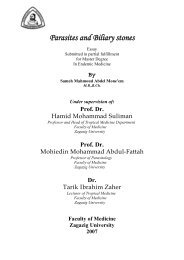Study of respiratory symptoms among sputum positive
Study of respiratory symptoms among sputum positive
Study of respiratory symptoms among sputum positive
You also want an ePaper? Increase the reach of your titles
YUMPU automatically turns print PDFs into web optimized ePapers that Google loves.
..... -. '..,<br />
gf{ww0/£iteratttn<br />
Pulmonary tuberculosis<br />
Transmission <strong>of</strong> pulmonary tuberculosis:<br />
For many years tuberculosis was thought to be transmitted<br />
genetically and even today patients who have little or no idea <strong>of</strong>theory <strong>of</strong><br />
infection when informed <strong>of</strong> the diagnosis <strong>of</strong> tuberculosis may express<br />
surprise because it's not in may family doctor (Seaton et aI., 1989).<br />
Riley (1974), found that tuberculosis is transmitted by air borne<br />
spread from person to person via infected <strong>respiratory</strong> secretions. Inhalation<br />
<strong>of</strong> droplet nuclei containing the tubercle bacillus may result in infection.<br />
Respiratory droplets are produced when someone with pulmonary<br />
tuberculosis coughs or in the case <strong>of</strong> laryngeal tuberculosis, with speaking<br />
or singing, While these <strong>respiratory</strong> droplets are air borne, water evaporates,<br />
leaving 1-5 urn particles called droplet nuclei. Because <strong>of</strong>their small size,<br />
these droplet nuclei may remain suspended in air currents for hours and,<br />
when inhaled may escape the host's. When these droplet nuclei reach the<br />
alveoli infection may result (Riley, 1974).<br />
Infectiousness <strong>of</strong>a tuberculous patient is dependent on the number <strong>of</strong><br />
tubercle bacilli expelled into the air. The bacilliary load is related to a<br />
number <strong>of</strong> factors, including presence <strong>of</strong> disease in the lungs, cavity<br />
formation, disease in the airways or pharynx, presence or induction <strong>of</strong><br />
cough. Failure <strong>of</strong> the patient to cover the mouth while coughing, and<br />
presence <strong>of</strong> AFB on microscopic examination <strong>of</strong><strong>sputum</strong> specimens. The<br />
period <strong>of</strong> infectiousness may be prolonged with in appropriate therapy <strong>of</strong><br />
tuberculosis (CDC 1990).<br />
23
















